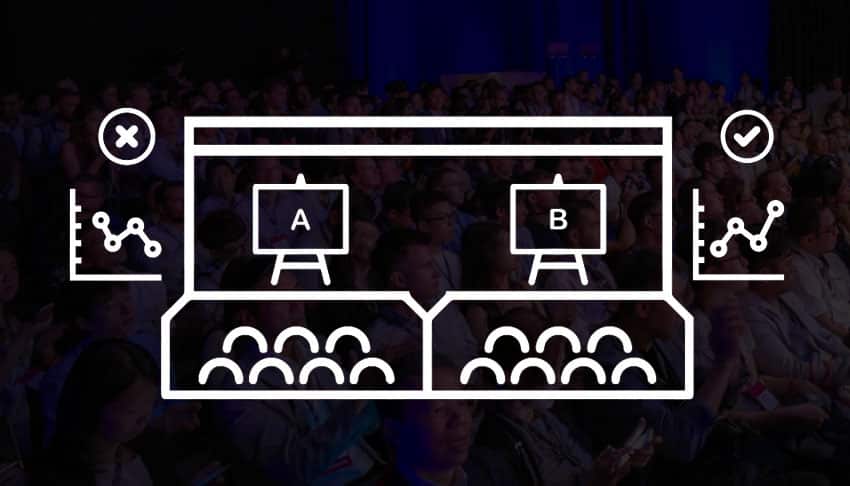Infographics: When A/B Testing, How to Decide What to Test?

A/B testing is the method in which two different versions of a website are tested against each other to see which one performs better. This method can also be called split testing and will involve showing the two different sites to different visitors during the same time period. The ‘winning’ website would be whichever performed better with visitors.
All websites serve a purpose and it’s essential that the purpose is achieved in the best possible way. In terms of business, manufacturers will create prototypes of their products and developers will create beta versions of their video games before they go on sale. This is all to make sure that any issues or problems can be recognised and fixed before release and that the best possible product is available to the public – Nobody likes a faulty product!
This process is just the same for companies operating online. For e-commerce websites, the purpose is to get their visitors to buy products and news websites wants readers to sign up for paid subscriptions or at the very least click on ads. The idea of any business website out there is to convert as many visitors into customers as possible.
A/B testing can be used to refine almost any aspect of a website from the likes of landing pages, calls-to-action, adverts and emails. In usual A/B testing, A would be the current version of the website or feature that you’re working with whilst B would be the alternative version.
According to Marketing Experiments, only 52% of companies and agencies that use landing pages will actually go through methods and processes to test them to help improve conversions from their visitors. AdPushUp reports that by using methods like A/B tests, companies could see up to 300% increase in their conversion rates which certainly shows just how fundamental taking conversion tests can be to your business and website. Eisenberg Holdings says that companies can spend up to $92 bringing traffic to their site but will averagely only spend $1 on conversion which shows a total lack of businesses understanding the vital importance that A/B testing can have.
The essential tips needed to know when going through an A/B test.
- Make a plan
Just like in anything, the right amount of organisation and planning will go a long way. Decide what it is you want to improve on your website and what you can do to achieve this. Make sure you have a clear, defined target in mind and then you’re ready to get started.
- Pick one variable
Many businesses make the common mistake of trying to fix everything at the same time. This doesn’t really solve the problems and it definitely doesn’t help when trying to pinpoint what does and doesn’t work for you. The best way to go about it is to pick one variable at a time and put all your effort into making that one achieve its intended purpose. By changing one thing at a time, you can see how it affects your conversion rate.
- Keep tests to a maximum of two months
A typical A/B test would normally run for more than a week but definitely no longer than two months. You need to run your test for long enough to notice any regular occurrences or trends amongst your viewers, and it’s important to know that your conversion rate can greatly differ depending on the day of the week. However, at the same time, running your test too long will add more variables into the mix which could affect the results of the test and your understanding of what works. Taking too long can also have an impact on resources spent and an ineffective use of time. Maximise the learning’s by minimizing the effect of time marching on.
- Eliminate F.U.D’s
What’s a F.U.D, you may ask. It simply stands for Fears, Uncertainties and Doubts and these are what stand in the way between you and a successful conversion of traffic. Change can be a scary thing but it can also have a massive impact on whether you are successful or not.
Identify where and what your F.U.D’s lie and find out how you can effectively eliminate them. Identify any element such as copy or images that may cause friction as these will prevent conversions following through.
- Do the maths
Ensuring your results will be statistically significant is crucial before starting to implement any changes to your site. The more variables you add to the equation then it is more likely that your results will not only be confusing but also misleading. A/B testing is all based around probability. By making positive changes, it is more likely that it will have a better impact on your website and ultimately convert more visitors into customers. So once you’ve worked done the maths on your site and the variables, then you’re ready to get testing.
- Test, repeat! Test, repeat!
Once your test is over – it’s time to look at the results and implement the changes that you’ve realised need to be changed. It’s important that you refer back to your tests, to make sure you’ve made the proper and relevant changes. By reviewing your test at the end of each quarter, you can show if the results were accurate and managed to achieve what was intended and to even see if other things come into play, such as seasonal factors. You can assess the trends of your visitors and make sure you’re meeting them.
It’s important to remember that A/B testing is just a test. You have nothing to lose however you have lots to gain. By testing you are able to see the impact that the changes would have on your site and business before you actually fully roll the changes out and implement them. Even the smallest of tweaks and changes can seriously help improve your site.
If you stay one step ahead of the competition, you can keep an eye out for the things to improve on and A/B testing is one way of figuring out what improvements you can effectively make. Be sure to check out the infographic below for a more visualised description on how any newbies can use A/B testing to their advantage.
Photo: Infographics (A Newbie’s Guide to A/B Testing) | Click to get the full Infographic.
Bring the best of the CEOWORLD magazine's global journalism to audiences in the United States and around the world. - Add CEOWORLD magazine to your Google News feed.
Follow CEOWORLD magazine headlines on: Google News, LinkedIn, Twitter, and Facebook.
Copyright 2025 The CEOWORLD magazine. All rights reserved. This material (and any extract from it) must not be copied, redistributed or placed on any website, without CEOWORLD magazine' prior written consent. For media queries, please contact: info@ceoworld.biz










